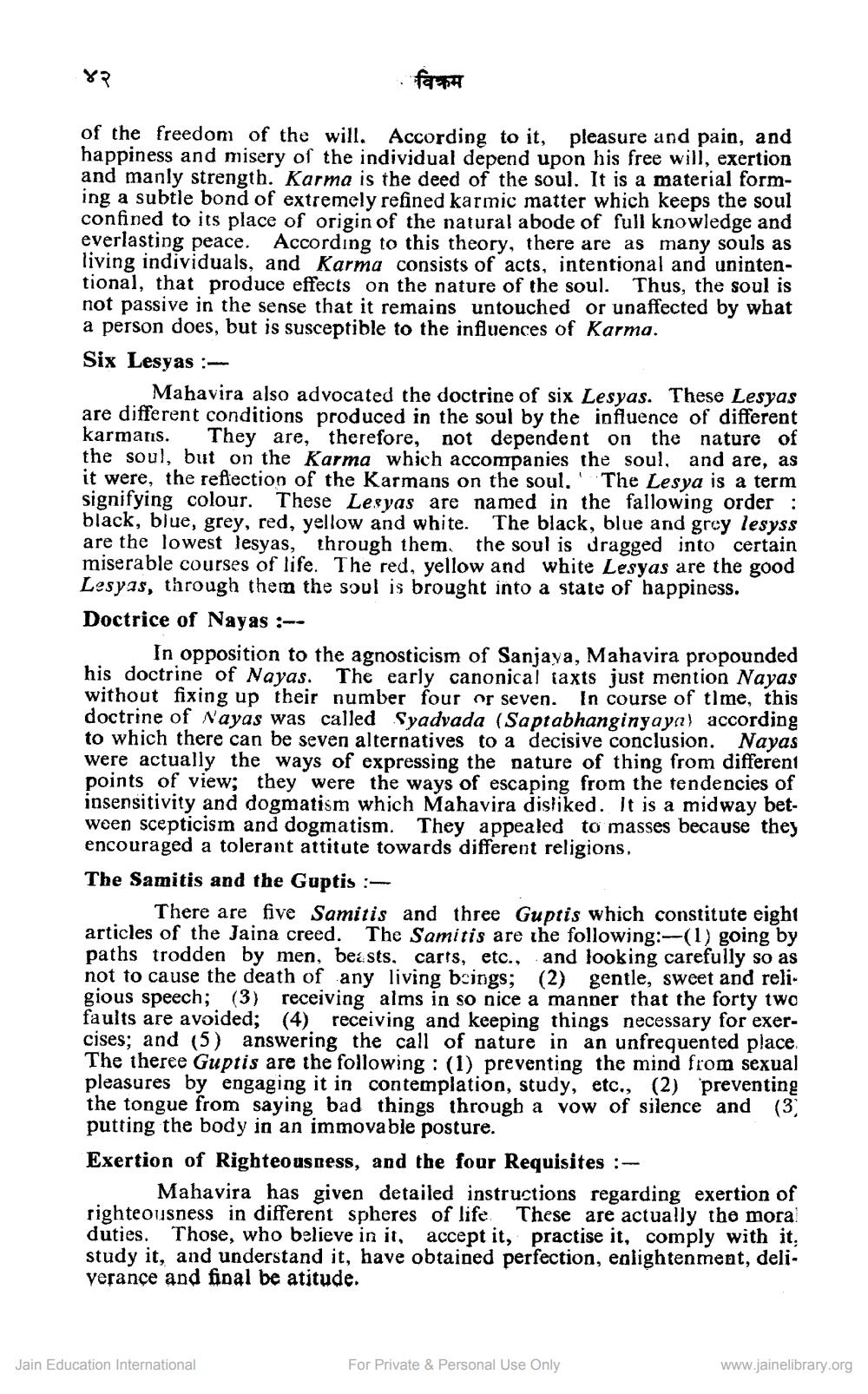________________
विक्रम
of the freedom of the will. According to it, pleasure and pain, and happiness and misery of the individual depend upon his free will, exertion and manly strength. Karma is the deed of the soul. It is a material forming a subtle bond of extremely refined karmic matter which keeps the soul confined to its place of origin of the natural abode of full knowledge and everlasting peace. According to this theory, there are as many souls as living individuals, and Karma consists of acts, intentional and unintentional, that produce effects on the nature of the soul. Thus, the soul is not passive in the sense that it remains untouched or unaffected by what a person does, but is susceptible to the influences of Karma.
Six Lesyas:
४२
Mahavira also advocated the doctrine of six Lesyas. These Lesyas are different conditions produced in the soul by the influence of different karmans. They are, therefore, not dependent on the nature of the soul, but on the Karma which accompanies the soul, and are, as it were, the reflection of the Karmans on the soul." The Lesya is a term signifying colour. These Lesyas are named in the fallowing order : black, blue, grey, red, yellow and white. The black, blue and grey lesyss are the lowest lesyas, through them. the soul is dragged into certain miserable courses of life. The red, yellow and white Lesyas are the good Lesyas, through them the soul is brought into a state of happiness. Doctrice of Nayas :--
In opposition to the agnosticism of Sanjaya, Mahavira propounded his doctrine of Nayas. The early canonical taxts just mention Nayas without fixing up their number four or seven. In course of time, this doctrine of Nayas was called Syadvada (Saptabhanginyaya) according to which there can be seven alternatives to a decisive conclusion. Nayas were actually the ways of expressing the nature of thing from different points of view; they were the ways of escaping from the tendencies of insensitivity and dogmatism which Mahavira disliked. It is a midway between scepticism and dogmatism. They appealed to masses because they encouraged a tolerant attitute towards different religions,
The Samitis and the Guptis :
There are five Samitis and three Guptis which constitute eight articles of the Jaina creed. The Samitis are the following:-(1) going by paths trodden by men, beasts. carts, etc., and looking carefully so as not to cause the death of any living beings; (2) gentle, sweet and reli. gious speech; (3) receiving alms in so nice a manner that the forty two faults are avoided; (4) receiving and keeping things necessary for exercises; and (5) answering the call of nature in an unfrequented place. The therce Guptis are the following: (1) preventing the mind from sexual pleasures by engaging it in contemplation, study, etc., (2) preventing the tongue from saying bad things through a vow of silence and (3) putting the body in an immovable posture.
Exertion of Righteousness, and the four Requisites :
Mahavira has given detailed instructions regarding exertion of righteousness in different spheres of life. These are actually the moral duties. Those, who believe in it, accept it, practise it, comply with it, study it, and understand it, have obtained perfection, enlightenment, deliverance and final be atitude.
Jain Education International
For Private & Personal Use Only
www.jainelibrary.org




